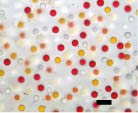James Dearworth Jr.

Degrees
- B.S., University of Michigan
- Ph.D., University of Delaware
I direct student-based research that examines the anatomy of vertebrates focusing on the functional anatomy of vision. Students in my laboratory investigate the functional anatomical mapping of the turtle retina to address how the vertebrate retina processes color and motion. In addition to the functional morphology of the turtle retina, other brain areas are examined to investigate reflexive eye movements: the pupillary response to light and the response to rapidly approaching targets. Student projects also examine the control of eye movements for tracking targets moving in depth. My biological research interests intersect with the field of neuroscience.
Learn more about the Neuroscience Program
Learn more about my teaching and research
Publications:
1. Functional anatomical mapping of the turtle retina. The turtle possesses one of the most complex retinas found among vertebrates. Using this neural network, my research investigates the anatomical substrates underlying sensory processes which lead to visual functions. My laboratory uses electrophysiological, pharmacological, and molecular methods to examine the anatomy and function of the retina. One of our recent studies identified melanopsin in the retina the turtle.
- Dearworth, J.R., Selvarajah, B.P. (’12), Kalman, R.A. (’10) , Lanzone, A.J. (’08), Goch, A.M. (’10), Boyd, A.B. (’08), Goldberg, L.A. (’12), & Cooper, L.J. (’07) (2011). A mammalian melanopsin in the retina of a fresh water turtle, the red-eared slider (Trachemys scripta elegans). Vision Research 51, 288-295. PMID: 21050869
-

Oil droplets in the turtle retina. Scale bar is equal to 10 micrometers.
Marcincin, C.L. (’06) & Dearworth, J.R., Jr. (2006). Computer image analysis of retinal oil droplets in different vertebrate species. Journal of the Pennsylvania Academy of Science 79: 116 (abstract).
- Dearworth, J.R., Jr. & Granda, A.M. (2002). Multiplied functions unify shapes of ganglion-cell receptive fields in retina of turtle. Journal of Vision 2(3): 204-217. PMID: 12678583
- Granda, A.M., Dearworth, J.R., Jr., & Subramaniam, B. (1999). Balanced interactions in ganglion-cell receptive fields. Visual Neuroscience 16(2): 319-332. PMID: 10367966
2. Sensory processing done by the retina evokes reflexive motor behaviors which help protect the eye and aid in image formation. These include the pupillary light response and eye blinks. Light responses evoking pupil closure can even be initiated by photoreception occurring within iris cells themselves.
- Sipe, G.O. (’10), Dearworth, J.R., Selvarajah, B.P. (’12), Blaum, J.F. (’08), Littlefield, T.E. (’07), Fink, D.A. (’07), Casey, C.N. (’07), & McDougal, D.H. (2011). Spectral sensitivity of the photointrinsic iris in the red-eared slider turtle (Trachemys scripta elegans). Vision Research 51 , 120-133, (2011). PMID: 20951155
-

As part of her independent study project, Erin Brune (’05, BS, Biology), inserts a turtle into a light-integrating sphere to measure the consensual pupillary light response.
Dearworth, J.R., Sipe, G.O. (’10), Cooper, L.J. (’07), Brune, E.E. (’05), Boyd, A.L. (’06), & Riegel, R.A.L. (’07) (2010). Consensual pupillary light response in the red-eared slider turtle (Trachemys scripta elegans). Vision Research 50 , 598-605. PMID: 20079368
- Dearworth, J.R., Brenner, J.E. (’07), Blaum, J.F. (’08), Littlefield, T.E. (’07), Fink, D.A. (’07), Romano, J.M. (’10), & Jones, M.S. (2009). Pupil constriction evoked in vitro by stimulation of the oculomotor nerve in the turtle (Trachemys scripta elegans). Visual Neuroscience 26, , 309-318. PMID: 19523265
- Kelly, J.N. (’07), George, K.R. (’07), Karwiel, A.N. (’07), & Dearworth, J.R. (2007). Blink response of the red eared slider turtle. Journal of the Pennsylvania Academy of Science, Vol. 80, 114, (Abstract).
- Dearworth, J.R. & Cooper, L.J. (’07) (2008). Sympathetic influence on the pupillary light response in three red-eared slider turtles (Trachemys scripta elegans). Veterinary Ophthalmology 11, 306-313. PMID: 19046290
- Dearworth, J.R., Cooper, L.J. (’07), & McGee, C. (’05) (2007). Parasympathetic control of the pupillary light response in the red-eared slider turtle, Pseudemys scripta elegans. Veterinary Ophthalmology 10, 106-110. PMID: 17324166
- Dearworth, J.R., Jr. & Gamlin, P.D.R. (2002). Periarcuate cortex neurons sensitive to rapidly approaching targets. 2002 Abstract Viewer/Itinerary Planner. Program number 56.12. Orlando, FL: Society for Neuroscience.
- Granda, A.M., Dearworth, J.R., Jr., Kittila, C.A., & Boyd, W.D. (1995). The pupillary response to light in the turtle. Visual Neuroscience 12(6), 1127-1133. PMID: 8962831
3. Sensory processes in the retina also initiate more complicated behaviors. In humans and other frontal eyed animals, these include vergence eye movements, the eye movements used for tracking targets moving in depth. Eyes converge to track targets moving inward and diverge to track targets moving away.
- Dearworth, J.R., Jr., Davison, R.C., Li., X., & Gamlin, P.D.R. (2005). Vergence target selection in rhesus monkeys: behavior and modeling. Vision Research 45(6) , 731-747. PMID: 15639500
- Dearworth, J.R., Jr., R.C. Davison, & P.D.R. Gamlin. (2004). Vergence target selection in rhesus monkeys: behavior and modeling, Society for Neuroscience, Vol. 30 (Program number 378.7), (Abstract).
- Dearworth, J.R., Jr., Li, X., & Gamlin, P.D.R. (2001). Primate frontal cortex contains neurons that respond to motion-in-depth stimuli. Society for Neuroscience, 27 (Program number 165.28), (Abstract).
4. I design my courses so that students are given a practical hands-on approach. These include performing laboratory exercises, critiquing primary literature sources, and designing research projects.
- Mead, K., Dearworth, J., Grisham, W., Herin, G.A., Jarrard, H., Paul, C.A., Waldeck, R., Yates, J., & Young, J. (2007). IFEL TOUR: A Description of the Introduction to FUN Electrophysiology Labs Workshop at Bowdoin College, July 27-30, and the Resultant Faculty Learning Community. The Journal of Undergraduate Neuroscience Education (JUNE), Spring 2007, 5(2): A42-A48.